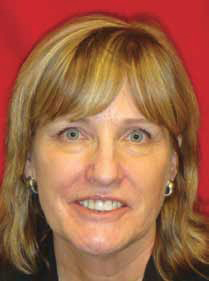CIO Profile: Patricia Haughney, Chief Information Officer, Barrington (IL) Community Unit School District 220

Quick Bio
Name: Patricia Haughney
Title: Chief Information Officer
District: Barrington (IL)
Community Unit School District 220
What are your big-picture tech goals?
We are focused on how we accomplish the 4Cs (Critical thinking and problem solving, Communication, Collaboration, and Creativity and innovation) and providing the technology that seamlessly makes that happen. We started by looking at how adults work, and we realized we don’t use our computers all day but we can’t be productive without them. An office laptop cart? No way. We view the role of school as education but we also have the responsibility to teach our children to be ethical and socially responsible. We must teach them how to learn, how to be intellectually curious and to be team players. We’re working toward a blended model because that’s how we work and we want to give our kids access to the same information.
We provide a 1:1 device for our sixth through eighth graders—an hp notebook running Linux. We’re now working on doing the same for all fourth graders and up through high school. For now, we’re trying to determine the best device. What will work best at elementary, middle and high school? For now, we’re focused on notebooks and starting to pilot test iPads in our pre-K through second grade classes. We need the most cost-effective device that offers flexibility.
We’re doing a lot of PD and focusing on Google Apps, which our teachers like. The middle schools are using Google Apps a lot. We have a Google-certified trainer who does a lot of PD via Skype and other methods. During the summer, she runs large academies (Teacher Institute Days) and has trained her assistants to work with teachers.
What changes are you taking to achieve these goals?
Tools and ideas to transform education. Sign up below.
We’re changing to a responsible use policy and teaching students to ethically manage their devices because it’s much better to have the devices 24/7. If a student goes to a bad website we make them hand write their assignments. So we’re working on responsible use, offering lots of PD, purchasing low-cost devices, and building the infrastructure. We put a lot into our bandwidth—upgraded the network, installed wireless everywhere. Our state has a consortium to help with funding.
What are the biggest challenges in your day-today life and how do you manage them?
We have an economic challenge; money is tightening and people are less willing to support the district. Now that technology is ubiquitous, everyone thinks they can tell us how to manage it. A lot of people tell us how to handle things, but I don’t tell my network guy how to run the switches. I respect his expertise and time crunch. These days, we are all doing more with less.
I try to avoid teacher bashing. They’re overburdened. I want to be the safety net at the beginning and model what they should be doing. We have to give teachers more credit and respect everyone’s expertise. Let’s honor each other.
How do you get buy-in on ed tech from the school community?
We are fortunate to have a pretty supportive community. We have a great chief communications officer who does email blasts and e-newsletters to give parents information. If my superintendent and Board are committed to something, they know what’s going to be challenging and what the parents will want. We also invite feedback with surveys and try to understand what’s important to the community.
What currently has you really excited?
I’m thrilled that we are starting to shift our curriculum to be more research based with a variety of resources. We use LibGuides (http:// www.springshare.com/libguides/); it’s a system for creating research guides and sharing them—kind of like an electronic file folder. One tab could lead to video resources of the Civil War; another can be stuff from the library. It’s a subscription service that’s very exciting. Teachers can build one and put it online.
